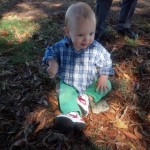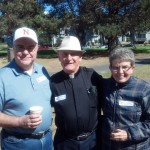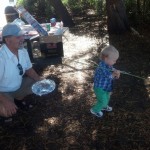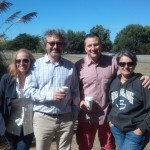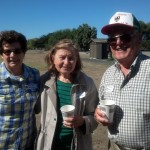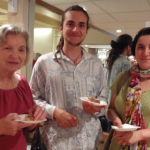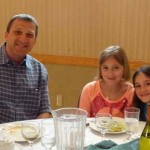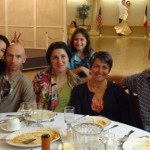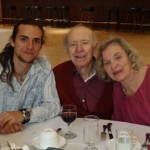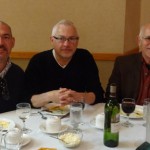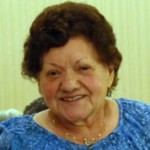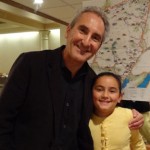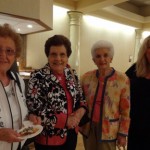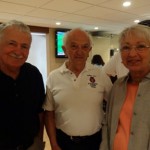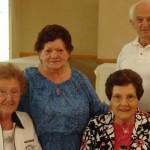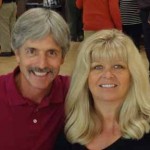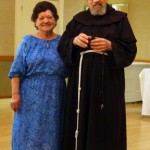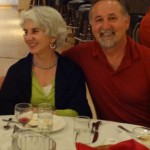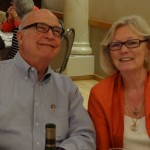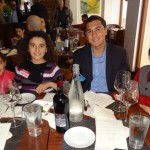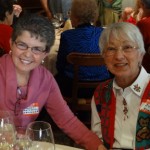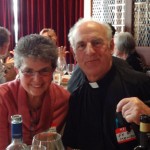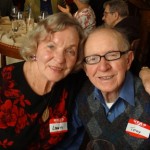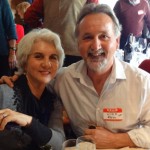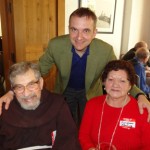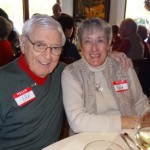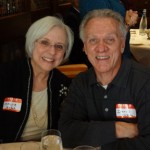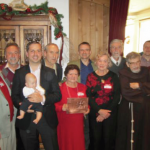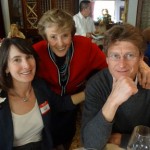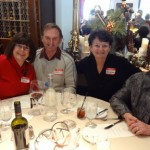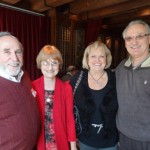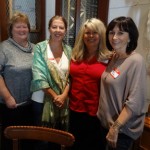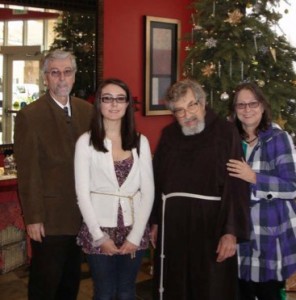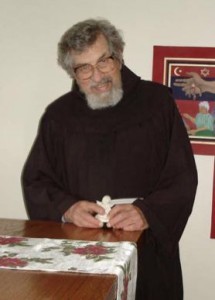Visitors from Rovereto
In October Dan Aspromonte hosted from Rovereto Sara Bozzi and her father Claudio and Fabio Bertolissi and his father Massimo. They traveled through California, Arizona and Nevada visiting several national parks and other sites along the way. 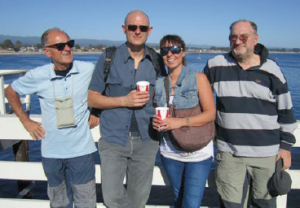 Noteworthy to us members of the Trentino diaspora is Fabio’s research on Trentino emigration. In 2009 he published a thesis at the Ca’ Foscari University of Venice on Trentino immigration to Bosnia, and then from Bosina to Agro Pontino, the former marshland south of Rome. The Trentino History Museum Foundation awarded him the year’s best thesis on Trentino
Noteworthy to us members of the Trentino diaspora is Fabio’s research on Trentino emigration. In 2009 he published a thesis at the Ca’ Foscari University of Venice on Trentino immigration to Bosnia, and then from Bosina to Agro Pontino, the former marshland south of Rome. The Trentino History Museum Foundation awarded him the year’s best thesis on Trentino
emigration. Vincenzo Mancuso from the same Foundation interviewed many of our club members last year, and snippets of those interviews will soon appear on television in Trentino. Most of emigration to Bosnia occurred 130 years ago from Aldeno, about 6 miles southwest of Trento, to Mahovljani. Why Bosnia? In part it was an effort by the Austro-Hungarian Empire to stem the rush of immigrants to the Americas. Fabio cites several reasons for Trentino immigration in that period of time: the international financial crisis; changes in political borders; flood disasters; diseases that devastated vines and mulberries (silk). The town of Aldeno, on the banks of the Adige River, was affected by all the above, but in particular by a calamitous flood in 1882. Most of those who settled in the Muslim-dominated Bosnia were poor farm laborers. They were given land to cultivate. They grew grapes and established a flourishing wine industry. On the cover of the July issue of the Trentini nel Mondo magazine, there is a photo of the monument that was recently erected in Mahovljani in honor of these immigrants. The story does not end here. In 1818, after WWI, Trentino was no longer part of the Austro- Hungarian Empire. Bosnia became part of Yugoslavia, and the Yugoslav government wanted these Trentini to serve in the military. Only a few had become citizens. They appealed for help, and in 1928 the Italian government granted them passports. In 1940 nearly the entire Trentino population of Mahovljani, about 100 families, sold their land and transferred to the marshlands of Agro Pontino, south of Rome. Mussolini had embarked on what he referred to as “the battle of the swamps.” With an army of workers he had these swamps drained, stripped of malaria and made into arable land. The Trentini, with origins in Aldeno, remained united, and many established noteworthy vineyards and wineries.
Some Trentini remained in Bosnia. The Province of Trentino is now providing them assistance in establishing productive vineyards and quality wines. In the future Fabio would like to trace Trentino involvement in the grape and wine industries of Brazil. In the meanwhile he is working on a project for the Trentino History Museum Foundation. He is researching the archives of Vallagarina to document migratory trends towards the end of the 19th century, mostly destined for Brazil. Rovereto and 16 other municipalities comprise the district of Vallagarina. Fabio offers his generous assistance to any of our members who are researching their ancestry in Vallagarina.
Trentino Visitor from Mexico City
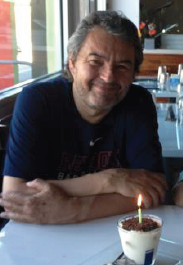 Oscar Zueck, former president of the Trentino club of Mexico City, paid us another visit in September. Now that he is retired, he is finally finding time to complete a thesis and book on Trentino immigration to Mexico. He is also trying to establish an online business in Mexico, selling vintage LPs and CDs. He has been collecting music for years, and now he wants to turn his hobby into a business. He bought boxes and boxes of LPs and CDs on this trip to California. While on a short stopover in Santa Cruz, he celebrated his 60th birthday with Dan Aspromonte. They had lunch and tiramisu for desert. Tiramisu literally means “pick-me-upper”, appropriate for someone reaching a milestone like 60.
Oscar Zueck, former president of the Trentino club of Mexico City, paid us another visit in September. Now that he is retired, he is finally finding time to complete a thesis and book on Trentino immigration to Mexico. He is also trying to establish an online business in Mexico, selling vintage LPs and CDs. He has been collecting music for years, and now he wants to turn his hobby into a business. He bought boxes and boxes of LPs and CDs on this trip to California. While on a short stopover in Santa Cruz, he celebrated his 60th birthday with Dan Aspromonte. They had lunch and tiramisu for desert. Tiramisu literally means “pick-me-upper”, appropriate for someone reaching a milestone like 60.
Picnic at the Crown Memorial Beach in Alameda
A big thank you to Roger and Judy Ecker for organizing the September picnic at the Crown Memorial Beach in Alameda, with gorgeous views of the San Francisco skyline.
The kids had a blast swimming in the Bay, kiting, etc. Thanks to all who participated and shared a delicacy. We will certainly return to this venue in the future.
Second Visit for Trentino High-Tech Entrepreneurs
Last June Jari Ognibeni, Alberto Gasperi and Giorgio Casoni of Spinnvest in Rovereto organized a visit to the Bay Area for several high tech entrepreneurs. At the time the officers of our club joined them for dinner at Donato’s Enoteca. Rinaldo Cis, Tarcisio Pedrotti and Luca Dorigatti from our club also lent their assistance to the group.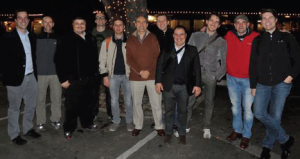
Alberto Tafner, President of the Trentini nel Mondo Association, followed up with a letter praising us for welcoming this group with open arms.
Spinnvest brought another group to the area in December. Some visited Tarcisio’s company, Distinct Corporation, and we met up with a contingent of the group in Palo Alto one evening. Spinnvest plans on organizing ongoing trips to the Bay Area. The goal is to create partnerships and new opportunities for businesses in Trentino and beyond. We look forward to meeting up with them in the future.
Spring Luncheon – Pranzo di Primavera 2013
Spring Luncheon April 2013 – Peninsula Italian American Social Club, San Mateo
Chef Andrea prepared lunch for us. He is from Sicily but has worked in many parts of Italy, including Folgaria in Trentino. The meal consisted of mixed antipasti and bruschetta con funghi (mushrooms) as a starter, followed by a choice of rigatoni con ragu al cinghiale (wild boar sauce) or pasta al pesto. For the main dish there was a choice of chicken piccata, veal scallopine ai funghi (mushrooms) or eggplant parmesan, and for dessert strudel and ice-cream.
Trentino Visitor
Laura Vitlacil’s nephew, Eugenio Bortolon, who attended the spring luncheon at the Peninsula Italian American Social Club. At the event he was pleasantly surprised to meet up with Michael Job. A few years ago Michael had given a talk at Eugenio’s high school in Borgo Valsugana. He spoke about his life’s journey, and in particular, his Vietnam War experience.
50th wedding anniversary
 Rino Zueck and Gemma Angeli Zueck married on February 23, 1963 in Santa Cruz. They celebrated their 50th wedding anniversary in Santa Cruz surrounded by family and friends. They received a special blessing from Father Albert Mengon from our club. Gemma was born in 1934 and raised in Cloz, Val di Non along with 6 brothers and sisters. Rino was born 10 months later in the adjacent village of Brez. In 1950 Rino’s family immigrated to Colorado. After a stint in the Air Force, Rino relocated to Santa Cruz to be near his sister Elena and his Prevedelli cousins in Watsonville. Gemma arrived on December 23, 1962, and they married exactly three months later. The couple had two children, Roseanne and John. Rino worked for San Lorenzo Lumber for over 40 years.
Rino Zueck and Gemma Angeli Zueck married on February 23, 1963 in Santa Cruz. They celebrated their 50th wedding anniversary in Santa Cruz surrounded by family and friends. They received a special blessing from Father Albert Mengon from our club. Gemma was born in 1934 and raised in Cloz, Val di Non along with 6 brothers and sisters. Rino was born 10 months later in the adjacent village of Brez. In 1950 Rino’s family immigrated to Colorado. After a stint in the Air Force, Rino relocated to Santa Cruz to be near his sister Elena and his Prevedelli cousins in Watsonville. Gemma arrived on December 23, 1962, and they married exactly three months later. The couple had two children, Roseanne and John. Rino worked for San Lorenzo Lumber for over 40 years.  After many treasured years raising their own children, they have been blessed with three grandchildren – Elizabeth, Joshua, and Christopher.
After many treasured years raising their own children, they have been blessed with three grandchildren – Elizabeth, Joshua, and Christopher.
Congratulations to Rino and Gemma on reaching this milestone!
An Immigrant’s Story of Tragedy and Good Fortune
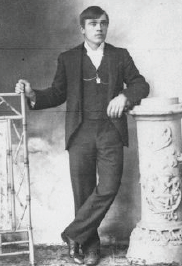
Ron Marinelli is a member of our club. Michael Marnella, Ron’s brother in San Clemente, below shares their family’s fascinating journey from the Val di Non to California.
We encourage other club members to submit their stories and photos. My ancestors originated in the villages of Casez, Banco and Sanzeno in the Val di Non. My great grandfather Raffaele, in the US Rafaeli or “Ray”, immigrated to the mining town of Nevadaville, Colorado when he was 8 years old. Orphaned at 9, he along with his two brothers survived by sleeping in a stable in exchange for cleaning up after the horses. They found themselves in a rough and tumble mining town without knowledge of the language or culture and also without parents. At age twelve he went to work in the mines. As a child he worked twelve hours a day, six days a week.
Being small of stature, they used him to crawl into the cracks and crevices to plant explosives. It was a very dangerous job, but
small Italian boys were an expendable commodity then.
Through a lot of hard work, some talent and a little bit of luck, he became foreman of the mine by age 24. Thereafter, he married the daughter of a mining engineer. Nevadaville was then known as “Bald Mountain” because it had been completely deforested for use as mine timber. Amazingly, the house where they lived is still standing. I have a photograph circa 1900 of them in their front yard watching as a 20-mule team passed by pulling heavy equipment to one of the local mines. It is perhaps 2 miles from Central City.
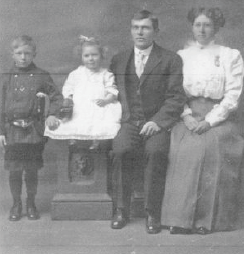
Both locations were very productive silver mining towns. There is a forgotten cemetery there within the abandoned ruins of the once thriving town with many Trentini names on the headstones.
My great uncle by marriage owned the saloon, and another still the water works. If someone wanted a drink of any sort, water or something stronger, it had to be
purchased from an enterprising Trentino.
The drills they used in the mines were called “widow makers” because of the
danger involved in their use and the disease they later caused. They did their work. Our
great-grandfather “Ray” died prematurely of black lung disease after spending the last six
months of his life literally coughing up blood and parts of what were once his lungs. His
shortened life’s purpose was to make the lives of his children and grandchildren better than his own. That purpose and sacrifice is one that I attempt to build on every day.
He was a quiet man who preferred never to speak of his childhood or history, traumatic as it was. In his pocket the day he died, he carried then and every day before that
three things: a pocket watch with a braided piece of his wife’s hair, a small prayer book given to him by his mother the day he left Casez, and a worn, stained letter that his father had mailed to him many years before.
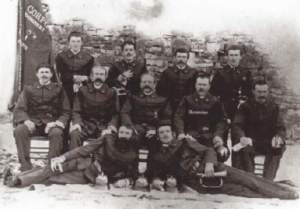
Those items remained in a trunk, long forgotten until the death of my great aunt many years later. The prayer book and letter then came into my possession. Consumed by curiosity, I photocopied the letter and with fingers crossed I
blindly mailed it to the parish priest in Casez, the town from which the original letter had originated. I asked if the church had any record of my family. The priest read my letter to the congregation the next Sunday in Mass. Several hands went up. Through this act of great kindness and luck, I was reconnected with family long lost. As it turned out, I had cousins still living in the family home, the Castle of Casez, and familial friends throughout the small town such as the DeConcini’s just across the street. We immediately booked passage to the Val di Non. Note on the family’s last name: When my greatgrandfather arrived in New York with his family, the immigration clerk misspelled their last name
“Marnella”. Uncomfortable challenging what he saw as governmental authority, my great-grandfather lived with the error the rest of his life.
We never knew it had been anything else. It was only after rediscovering our past that the
clerical error was uncovered. Ron elected to legally change his name back to the original
spelling. I felt I had so many miles under my belt, legal documents, degrees, licenses and
children under the name Marnella, that I chose the path of least resistance and like my
great-grandfather, retained the errant spelling.
Consul General Mauro Battocchi. He is a Trentino!!!
Consul General Mauro Battocchi
Consul General of Italy in SF a TRENTINO!
Mauro Battocchi is from Tione, about 20 miles west of Trento. It is a town in the Valli Giudicarie with a population of around 3,600. According to the newspaper Trentino, his mother and brother still live in Tione. His father passed away, but his brother continues the family business, wholesale distribution of food products to hotels and stores. His sister, on the other hand, lives in Arco and teaches at Maffei, a secondary school in Riva del Garda.
One of our members, Maurizio “Tito” Ghezzi of Sunnyvale, is also from Tione. Che mondo piccolo! (It’s a small world!) He fondly remembers Mr. Battocchi’s father: un uomo benvoluto (a well-liked gentleman). The consul general is known to be as amicable as his father, as shown in this video message:
http://www.youtube.com/watch?v=NqjUt8MA8gw.
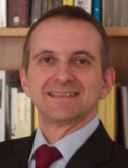 A Foreign Service officer specialized in economic issues, he worked in the private
A Foreign Service officer specialized in economic issues, he worked in the private
sector from 2008 to 2012 at Enel, a multinational power company, as Vice-President for
international governmental affairs. Previously he headed the desk for trade and
investment promotion at the Italian Ministry of Foreign Affairs in Rome (2003-2008),
supporting the internationalization of Italian firms abroad. He was also the head of the
economic section of the Italian Embassy in Tel-Aviv (1999-2002) and served at the
financial section of the Italian Embassy in Bonn (1995-1999), taking part in the
negotiations for the start of the European Monetary Union. He graduated in economics at
Bocconi University, Milan, and received a Master’s degree in public policy at Princeton
University. Born in the Alpine region of Trentino, he likes hiking and skiing.
Mauro’s blog is at http://sanfranciscoitaly.com. It is chock full of very interesting
information. Consult the archive to get a quick view of its contents.
CHRISTMAS LUNCHEON – PRANZO DI NATALE 2012
Christmas luncheon December 2012 – Donato’s, Redwood City
Special Guest: Consul General Mauro Battocchi
According to a San Francisco Chronicle article, Consul General Mauro Battocchi is the “driving force” behind the Year of Italian Culture in the Bay Area. We had the immense pleasure of meeting Mr. Battocchi, a fellow Trentino from Tione, at our Christmas luncheon. As the article points out, he is not your “old school, formal and stuffy” diplomat. He is “accessible and down to earth. He tweets and blogs, skis, hikes and zooms around town in his Fiat 500 convertible.”
Mauro’s blog is at http://sanfranciscoitaly.com. It is chock full of very interesting information. Consult the archive to get a quick view of its contents, including a photo of our luncheon at Donato’s.
Padre Efrem
By Christine Bologna
HIS STORY
Padre Efrem was born on the 17th of May 1921 to 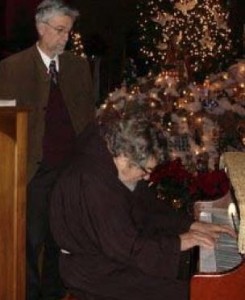 Maria Dellagiacoma “Accursio” and Andrea Trettel “Da Molin” in Predazzo, in the province of Trento. His baptism name is Mario Trettel. His mother was a native of Predazzo whilst his father was born in Tesero, only a few miles away. Mario was their second child with his elder sister born in 1919. Andrea Trettel was the son of a school teacher and he himself had also studied to be a teacher but preferred carpentry and had purchased his own workshop to build his life as a carpenter. It was a happy start to life, however life is unpredictable and tragedy soon hit this happy little family when a fire broke out in his workshop and destroyed everything that they owned. Penniless and in debt, the family moved to Caldonazzo where they spent the next three years in a two roomed home while the father was working on getting a full teaching credentials. After three years he got a full time teaching post in Trento and bought a “vecchio mulino”, an old windmill. He was now able to move his family from Caldonazzo to Trento. Moving to Trento and living in a small space, as all the family had to sleep in one room while his father restored the property to a home, Mario went to school there. These were hard times and one day Andrea met up with Mario who was returning home on his bike and asked him if he would go and stay with the Friars. In Padre Efrem’s words, in those days if your father asked you to do something, there really was nothing to do other than say “yes”. So within a matter of days, Mario was taken to the Friars in Vilazzano where he said “bye, bye” to his father and to the life he had known so far. In Caldonazzo he lived with about 60 other kids of whom only 5 or 6 became “frate”. Mario spent one year at Villazano and then went to Campo Maggiore, as he explained that this was towards the Adige going north, he noted that his memory was failing him and could not recall the name of the lake nearby.After three years at the Noviziate, the group of kids was now down to 9. It was war time he recalled, and many had been taken there because their dads had gone to war and there was no one to feed them. The rigors of a friar’s life were not, however, for everyone and most of them dropped out on the way. At this point he gave us more facts, but the sequence was a little hazy. Mario spent 3 years in high school in Rovereto while with the Friars (for those of you not familiar with the area that is 20km south of Trento), he then spent 4 years studying Theology in Trento and at the age of 24, in 1944 he celebrated his first mass. This was the beginning of his new life as a Franciscan missionary and in the Franciscan tradition he changed his name. He was now Padre Efrem. Padre Efrem spent one more year studying theology and then he was ready to take on whatever mission he was going to be sent to. His first year as a priest was spent in Arco, near Riva del Garda and he lived at the Noviziate while he helped out at the Arco parish. This was now the post war period and there were many needs throughout Italy. The Franciscan province, of which he was now a part had a need for someone to teach in Calabria, specifically in Tropea. I digress a moment here as I know Tropea well, having good friends there, this is an incredibly beautiful place with incredible beaches, I dare say that it is close to paradise – but even when I used to visit some 25 years ago there still was a lot of poverty in the area. After an evening out, it was common that a little kid under the age of 10 would ask you for some money because he or she had protected your car! So one can only imagine what this placewhich today lives off tourism was like in the post world war II era.
Maria Dellagiacoma “Accursio” and Andrea Trettel “Da Molin” in Predazzo, in the province of Trento. His baptism name is Mario Trettel. His mother was a native of Predazzo whilst his father was born in Tesero, only a few miles away. Mario was their second child with his elder sister born in 1919. Andrea Trettel was the son of a school teacher and he himself had also studied to be a teacher but preferred carpentry and had purchased his own workshop to build his life as a carpenter. It was a happy start to life, however life is unpredictable and tragedy soon hit this happy little family when a fire broke out in his workshop and destroyed everything that they owned. Penniless and in debt, the family moved to Caldonazzo where they spent the next three years in a two roomed home while the father was working on getting a full teaching credentials. After three years he got a full time teaching post in Trento and bought a “vecchio mulino”, an old windmill. He was now able to move his family from Caldonazzo to Trento. Moving to Trento and living in a small space, as all the family had to sleep in one room while his father restored the property to a home, Mario went to school there. These were hard times and one day Andrea met up with Mario who was returning home on his bike and asked him if he would go and stay with the Friars. In Padre Efrem’s words, in those days if your father asked you to do something, there really was nothing to do other than say “yes”. So within a matter of days, Mario was taken to the Friars in Vilazzano where he said “bye, bye” to his father and to the life he had known so far. In Caldonazzo he lived with about 60 other kids of whom only 5 or 6 became “frate”. Mario spent one year at Villazano and then went to Campo Maggiore, as he explained that this was towards the Adige going north, he noted that his memory was failing him and could not recall the name of the lake nearby.After three years at the Noviziate, the group of kids was now down to 9. It was war time he recalled, and many had been taken there because their dads had gone to war and there was no one to feed them. The rigors of a friar’s life were not, however, for everyone and most of them dropped out on the way. At this point he gave us more facts, but the sequence was a little hazy. Mario spent 3 years in high school in Rovereto while with the Friars (for those of you not familiar with the area that is 20km south of Trento), he then spent 4 years studying Theology in Trento and at the age of 24, in 1944 he celebrated his first mass. This was the beginning of his new life as a Franciscan missionary and in the Franciscan tradition he changed his name. He was now Padre Efrem. Padre Efrem spent one more year studying theology and then he was ready to take on whatever mission he was going to be sent to. His first year as a priest was spent in Arco, near Riva del Garda and he lived at the Noviziate while he helped out at the Arco parish. This was now the post war period and there were many needs throughout Italy. The Franciscan province, of which he was now a part had a need for someone to teach in Calabria, specifically in Tropea. I digress a moment here as I know Tropea well, having good friends there, this is an incredibly beautiful place with incredible beaches, I dare say that it is close to paradise – but even when I used to visit some 25 years ago there still was a lot of poverty in the area. After an evening out, it was common that a little kid under the age of 10 would ask you for some money because he or she had protected your car! So one can only imagine what this placewhich today lives off tourism was like in the post world war II era.
Back to Padre Efrem. As he remembers Tropea, a huge smile appears and he says “bellissimo” (most beautiful) in his own words “Ci’ho ancora il mio cuore a Tropea”. My heart is still in Tropea. While in Tropea he taught at the convent and in his spare time he went to help a priest who had started charitable work they called Susha. He essentially worked the streets of Tropea helping the very poor and destitute. So I asked him why he left. He told me that there was a mission going to China following the assassination of a Franciscan priest there, and his friends and fellow friars from Trento urged him to go with them. He felt obligated to leave. When he left Tropea he remembered that they had to stop the train for about 15 minutes because so many people had turned up to say goodbye and wish him well. He was very sad to leave this beautiful place and these wonderful people. Through my friend Emilio who knows many people in Tropea, I tried to find out if there was anyone who still remembered Padre Trettel in Tropea. Poor Emilio actually went visiting several people until he realized that this would be impossible given the dates we were talking about. Well I thought it would have been nice but realize that I had given him an impossible task! Back in Trento Padre Efrem quickly prepared for their journey to China. This was now around 1948. They set off by sea to New York, then to San Francisco where they stopped for two weeks at the Parish of the Immacolata Concezione which was run by the Trentino branch of the Franciscans. From San Francisco they took a boat to China and went straight to the mission on the Blue River. “Bello” he said as he reminisced on his memories of the journey. They spent 3 to 4 days in Shanghai as guests of the Salesians then took a 5 to 6 day journey on the river till they reached their destination. He spent four years in China, during which time he learnt about the culture and the language. When they arrived there, China was not yet under the communists but the communists did take over while he was there. They came from Manchuria in the north he recalled. They came in and took over the parish. The priests were allowed to carry on for a while but then they put the bishop and jail. While in jail, the bishop sent them a message telling them to leave. So they packed their bags and took a 3 day train ride to get to Hong Kong. From there, they took a plane that took four stops and they eventually landed in Rome from where they took a train back to Trento. Back in Trento the four of them were asked what they wanted to do. Two of them chose to return to the Orient. At this point in his story, Padre Efrem pauses to think of his old friends with whom he had also been to Japan and Korea where they led a church for those sick with leprosy. He spent one week in church with all the lepers and remembers the experience as very enriching and uplifting. Then he spared a thought for Padre Claudio, Padre Michele and Padre Lino who had been in his class at school; they are all gone he said, I am the only one left alive. Padre Efrem came to California in 1954. It was not a 12 hour plane ride to get here though, it took them one month. They set off from Naples by boat to New York where they spent one week. It was a beautiful and memorable journey he recalls with a big smile. Then it took another week across by land to San Francisco where he was to assist Padre Bazzanella. He started teaching. At this time there was a group of Italians who were doing radio in Italian and transmitting from Oakland. One day he was asked to drive a priest over to the recording studio to give a sermon on TV. This is the moment that changed his life. Within weeks of this visit he started his own transmissions. He would prepare the tapes for radio in his room and then send them over to various stations for transmission. He had done radio for 50 years and TV for the last 23 of those years. In San Francisco he was also a parish priest for many years. All the time he built a strong network taking care of making contracts and fundraising by organizing dinners to finance these transmissions. Padre Efrem was transmitting on 20 stations including Mississippi. After he fell down three years ago and the doctors told him he had to stop all these activities he had to terminate all these contracts. It was the hardest thing for him to do. He said that he has sent all his tapes and information about his activities to the museum of Trento. One can only hope that someone there will take the time to record the life of Padre Efrem Trettel and his many achievements and place them in some historic perspective. During his years in San Francisco, Padre Trettel organized several tours to Italy at low cost giving the opportunity to many Italian emigrants to return to their homeland and visit the families that they had left behind so many years earlier. He added that during those visits while everyone went to their home towns to visit with family he took the opportunity to go off to Trento to visit his own family. This of course was a rare treat for him and his family. At this point Padre Trettel exclaimed– that’s my story! I would have thought that we had tired him out, but at 89 he is still very enthusiastic and dynamic. He loves spending time with young people and he stopped to have a chat with my daughter and promised to make a “grop” that is a knot in Trentino, so that he would remember to say a prayer for her on her birthday which was coming up soon. Then he asked her, if she would you like to listen to some Christmas music; that’s more fun than listening to my story, he added! So we decided to head to the church where there is an organ and piano. But before the fun he wanted us to experience the dilemma of the many people suffering from Alzheimer. So first there was one stop. We went to the top floor of the home having to pass through a keycode locked door, to visit the Alzheimer residents and mainly to visit an old Korean priest who has Alzheimer The home has this special section for the elderly who are suffering from Alzheimer – it was a very touching and humbling experience. Padre Efrem is very worried that he may end up in that condition. But I am praying that he will not, his cheerful ways have so much to give the elderly at the home. And up we went for a visit to the church which is just across the street from the home. There was a beautiful crib laid out and we took some pictures. Padre Efrem then headed for the organ, not all the switches were on but he still managed to play some incredible music. He then took a shot at the piano. Wow what a musician he still is. He is quite impressive at the venerable age of 89! Padre Efrem has given his life so that others may have a better one. There are many members in the Trentini club. If each family could spare a few hours one week each year to visit him at Alma Via, then he would not feel cut off and lonely. I guarantee that you will get more out of this visit than you ever expected, I know I did.

